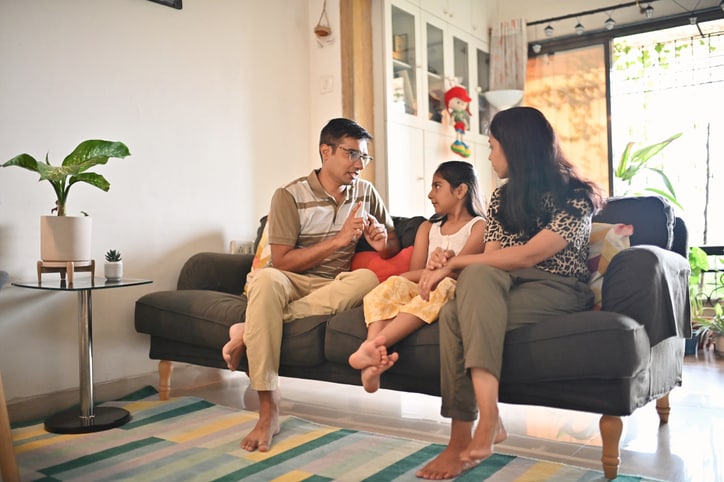Over the course of the past several weeks, we’ve all watched and read in sadness and anger as Black men and women have been senselessly killed in America. We’ve also watched as millions of Americans have taken to the streets to protest against police brutality, fight against systemic racism, and support the Black Lives Matter movement.
But it’s not just us who’ve been watching and reading and listening. Our kids have, too.
The murders of George Floyd, Breonna Taylor, Ahmaud Arbery and Rayshard Brooks have incited much-needed conversations about racism. And have left many of us wondering, how do we talk about this with our kids? How do we teach them about racial identity and equality? About what they should do if they see a schoolmate or friend being bullied because of the color of their skin or the texture of their hair? Or, if they are the one being bullied?
It’s not easy talking to kids about subjects that make adults feel uncomfortable — or that adults might not fully understand themselves. There’s a lot of learning we all need to do. But it’s time to start having these important conversations with our kids and with each other. And, most importantly, it’s time to act.
Dr. Beverly Daniel Tatum, is president emerita of Spelman College, an award-winning clinical psychologist and a national authority on racial issues in America. She recently joined Care.com CEO Tim Allen for a webinar called Talking to Kids About Race and Racism. With thousands of parents, teachers and caregivers in attendance, Dr. Tatum offered guidance on how to have important — often difficult — conversations with kids of all ages about race and racism that are empathetic, constructive, and compassionate.
Watch the webinar with Dr. Tatum (or listen to the podcast), and share it with your network of friends, family, colleagues, teachers, and caregivers. Here are key takeaways from the conversation.
Children aren’t colorblind, so don’t shhh their questions about racial difference
If you’ve spent time with a young child, then you know how inquisitive they are. There’s no social filter, either. As Dr. Tatum illustrates, if your white 5-year-old son suddenly blurts out, “Why is that man’s skin so dark?” in the middle of the supermarket, you’re left mortified. “Parents may respond with the well-known shhh when such a question gets asked,” she says. “But being able to answer a child’s question about difference is very helpful because they do notice it. They’re not colorblind.”
Dr. Tatum says that when you shhh a child for asking questions about differences in skin color, hair texture or eye shape, you’re reinforcing that they’re not supposed to talk about it. Ultimately, this leaves them confused. Instead, actively seek to have positive and affirming conversations about race that are right for their age. For toddlers and preschoolers, she recommends books with images that help children understand the differences found in the wider world. For a great list of these books and resources, visit Social Justice Books and Common Sense Media.
It’s never too early to talk to kids about racism
Children as young as 2 or 3 will begin noticing and asking questions about racial differences. But when it comes to discussing racial injustice with young children, Dr. Tatum recommends that parents approach these conversations by framing racism in terms that their young minds can grasp. “Racism is about unfairness,” she explains. “Kids are not too young to talk about it if we are talking about it relative to what’s fair and unfair.”
Dr. Tatum encourages following your child’s lead, listening carefully to the questions they’re asking to initiate the conversation. Use concrete examples that they can understand and pose questions that relate to their world. She suggests using an example like, “If I gave Tommy two cookies every afternoon and I only gave you one, would that be fair? No. Sometimes people are treated differently in our society because of the way they look, and that’s very unfair.”
Feel empowered to ask teachers and caregivers lots of questions
Do you know how the teachers and caregivers in your child’s life are communicating messages of fairness and racial difference? Dr. Tatum says one way to start is by simply taking a look around. Are the students and staff at school or day care racially diverse? What posters are on the walls? What books are on the shelves? If things are too homogenous, speak up.
She also suggests asking teachers and caregivers how they’re talking about difference with your kids. For instance, are they using multi-colored crayons to represent different skin colors? Asking these questions is especially important for parents of color who want to see their own children represented, and for them, it can often be a bigger task.
“These are questions that any parent can ask.” Dr. Tatum says. “Because every parent should want their child to grow up understanding that they live in a diverse world.”
Work to get outside your homogeneous bubble
Dr. Tatum cites a national study by PPRI in 2013, that found that 75% of white American adults move in entirely white social networks, without the presence of any people of color. But the world is becoming more diverse. Gen Z is the most racially diverse generation in history. If we don’t teach our kids how to live in a multicultural, multiracial environment, we are raising, as Dr. Tatum says, “social dinosaurs.”
It’s on us as parents and caregivers to diversify our children’s social networks — and ours, too. “If you’re a white parent and you’re living in a largely white community, your task is to think about how do I expand my child’s experience so they don’t grow up in this very homogeneous bubble?” That might mean extending beyond your comfort zone to make friends of color, but that’s how progress is made. Dr. Tatum suggests looking for activities that align with your interests — like joining a monthly book club, for instance — to force you outside of your bubble.
For Black parents, especially those living in predominantly white communities, Dr. Tatum describes the challenge of finding other children of color for their kids to be friends with. She suggests looking for opportunities both inside and outside of your community — a youth group, a choir, a church, or staying close with relatives who share their experiences and background.
Answer honestly when questions come up about police brutality and protests
No parent wants their child to see the George Floyd video. And it can be hard to explain to a young child why people are out on the streets protesting. But if they’re inadvertently exposed to the video, ask about police shootings and protests or even ask you, “Can this happen to me or you?” Dr. Tatum says you should discuss it honestly, but in an age-appropriate way, and emphasize how it’s not fair.
Reassure kids that they are safe by emphasizing that you, as their mom, dad or caregiver, are working hard to create change and make their world better. You might say to your child, “I’m here to protect you. And I’m going to make sure that those bad things never happen to you.”
Dr. Tatum recommends the book “Something Happened in Our Town: A Child’s Story About Racial Injustice,” which teaches kids how to identify racial bias and helps answer their questions about racial injustice at the hands of law enforcement.
Of course, this approach really only works with young children. For pre-teens or teens, Dr. Tatum says you can’t so easily reassure older kids with certainty. Black parents in particular need to teach their older children what they need to know and do to be safe outside of the home, especially when it comes to interactions with the police. These are difficult conversations, but Dr. Tatum says that if you don’t have them, then you run the risk of leaving your child vulnerable.
Use the ‘3 F Strategy’ to interact with adults who don’t share your views
Unfortunately, you will encounter other parents and adults in your and your child’s life who hold prejudicial attitudes or who are ill-informed on racial issues. No matter their intent, in these instances, Dr. Tatum says it’s constructive to turn these interactions into teachable moments.
For example, another parent might insist that, “We don’t see color in this family.” But you and your child know that seeing color is not a bad thing. In this case, Dr. Tatum recommends employing what she calls the “Three F Strategy,” using statements with the words “felt, found and feel.” Using this approach, your conversation with the other parent might go something like this:
-
There was a time when I felt the same way, that it was important to teach my kids not to see color.
-
But then I found out that kids do notice color; they just learn from a young age not to talk about it.
-
I want my child to appreciate our differences and know that there’s nothing wrong with seeing color. So now I feel that it’s important to celebrate and talk about diversity in a positive way with my child.
Dr. Tatum says that, while there is a relationship between prejudicial beliefs and racism, we should not conflate them. “Racism is not just prejudice. It’s not just negative attitudes about a particular person or sets of people,” she explains. “It’s about policies and practices and institutional contexts that form a system. And that system … has been operating in our country for a long time. It’s baked into our cultural context.”
She likens the systemic nature of racism to a moving walkway at the airport. Some people walk fast along with the walkway. “We might think of those people relative to racism as the active racists — the people who are embracing white supremacy and racial ideology,” Dr. Tatum says. Then there are others who are standing still on the walkway and gliding along with it. Such people may deny that they are racist but, as Dr. Tatum points out, “they’re still being carried along by that same conveyor belt” and not making any effort to walk against it. Finally, there are those who walk fervently against the walkway. These people can be seen as the active anti-racists. They know that the only way to interrupt systemic racism is to actively disrupt it. “We have to be working against those systems. We have to interrupt those policies and practices. We have to create new systems that are equitable and that don’t reinforce a racial hierarchy in our society,” Dr. Tatum says.
Sadly, racism is a part of who we are as a nation. It’s imbued in every facet of our society, whether we realize it or not. But attitudes are shifting. And Dr. Tatum is hopeful. “When I see the protests that have been happening around the country, one of the things that is striking to me is the significant presence of white people. And that is different.”
To ignore our past and deny our present is to damage our future … and rob our children of the chance to change it for the better. That change starts with us, as parents, teachers and caregivers. The next generation deserves nothing less.
You may also listen to this talk with Dr. Tatum via the Equal Parts podcast.
********
About Dr. Beverly Daniel Tatum:

Dr. Beverly Daniel Tatum, president emerita of Spelman College, is an award-winning clinical psychologist widely known for both her expertise on race relations and her thought leadership in higher education. Her book, “Why Are All the Black Kids Sitting Together in the Cafeteria? And Other Conversations about Race,” updated in 2017 for its 20th anniversary edition, is back on the New York Times best-seller list, 23 years after she wrote it. Dr. Tatum’s TEDx talk, Is My Skin Brown Because I Drank Chocolate Milk?, is a must-watch for all parents. She has recently appeared on “Coming Together: Standing Up to Racism – A CNN/Sesame Street Town Hall for Kids and Families,” NPR’s Here & Now, and the NBC News/MSNBC Into America podcast and has been interviewed by The New York Times and USA Today.
For more information, visit www.beverlydanieltatum.com, or follow Dr. Tatum on Twitter @BDTSpelman.






